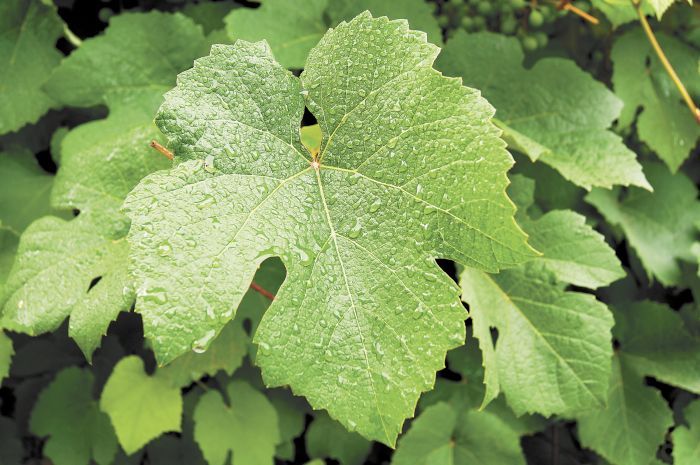Water ’N’ Wine

By Jessica Cortell
Water, nitrogen and wine: How are they connected? This was a major theme of the 2014 Oregon Wine Symposium, held in Portland at the Oregon Convention Center on Feb. 25 and 26.
Sessions relating to water, nitrogen and wine included: “Ebb & Flow: The Dynamics of Water Availability and Vine Use” by the new Oregon State University Southern Oregon researcher Dr. Vinay Pagay; “Water into Wine: The Downstream Effects of Vineyard Water Management on Wine Quality,” which featured Steve Price (ETS Labs); and a technical tasting titled “The role of Nitrogen from vine to wine,” exploring nitrogen’s effect on Pinot Gris aroma and flavor — the panel included Paul Schreiner (USDA-ARS), James Osborne (Oregon State Food Science and Technology) and Jungmin Lee (USDA-ARS).
Pagay discussed the grapevine growth cycle and the impact of the previous season’s water status on the development of the compound bud that produces the following season’s crop. He also outlined the grapevine soil-plant-atmosphere water potential continuum that is driven by transpiration.
The vine-water status is influenced by environmental conditions, soil characteristics, soil moisture and resistances in the plant. The two main factors driving water use are canopy size and evapo-transpiration. These factors are used to calculate the amount of water a vine uses on a weekly basis. In grapevines, the greatest resistance or control of water loss is through the stomata on the undersides of the leaves. If these close in response to drought stress, it will also have negative impacts on photosynthesis and nutrient uptake.
How does drought stress impact photosynthesis and ripening? There is a direct response as net photosynthesis per unit leaf area is correlated with net uptake of CO2 through the stomata. If the stomata are partially closed or closed due to drought stress, CO2 uptake will be much lower. Water typically moves out of the vine 40 times faster than CO2 can diffuse in. In photosynthesis, CO2 is needed to store the energy from the sun as carbohydrates.
Drought stress can also impact the uptake of nitrogen both directly and indirectly. Vines take up nitrogen from the soil solution, so if the soil is very dry, uptake will be more challenging. Also, vines actively take up nitrogen, so energy is spent on both uptake and assimilation. The assimilation of nitrate into amino acids is very costly as the vine uses as much as 25 percent of its energy from photosynthesis to assimilate nitrogen; while nitrogen is less than 2 percent of total plant dry weight. Consequently, nitrogen status is the major factor regarding vine vigor as mentioned by Schreiner in his presentation. Nitrogen can have both direct and indirect effects on wine quality.
Indirect effects from high nitrogen can include accelerated shoot growth and leaf size, which can impact the rate of fruit ripening and sunlight exposure in the canopy. Direct effects of excess nitrogen (high vigor) can also include lower biosynthesis of secondary plant metabolites such as phenolic compounds, important in red wines.
Excessive drought stress could cause indirect effects, such as low levels of amino acids in the fruit and a shift toward more proline relative to arginine. Arginine is the major yeast assimilable amino acid consumed during wine fermentation while proline is not consumed. Many aromas in wine are generated during fermentation from the conversion by yeasts of amino acids to higher alcohols. The higher alcohols can give wine floral and fruity aromas and flavors. Consequently, low amino acids, particularly in a white wine where the aromatics are very important, can have a big impact on the wine.
In the OWIS wine tasting panel, Pinot Gris wines were prepared by Osborne that included a control (no nitrogen addition), DAP (Diammonium-phosphate) addition and amino acid addition. In this blind tasting, the wine with the amino acid addition was just incredible in terms of aromatics while the control and the DAP treatment were quite limited in their aromatic profiles.
My conclusion? We need to consider how vine vigor, water status and nitrogen interact in affecting the final outcome of the fruit and wine. Obviously, simply adding DAP at the winery is not the same as developing amino acids in the fruit in the vineyard.
Another session at the symposium, “Water into Wine: The Downstream Effects of Vineyard Water Management on Wine Quality,” presented interesting information on changing water content in berries due to rain events. This relates to what we experienced during harvest in 2013, and will be discussed in the next OWP.
Growing Vocabulary
Transpiration: The process of water movement through a plant and its evaporation from aerial parts, such as from leaves but also from stems and flowers. Leaf surfaces are dotted with pores called stomata, and in most plants they are more numerous on the undersides of the foliage.
Compound bud: The normal type of bud which appears at each node along a vine shoot or cane. It contains not one but three separate, partially developed shoots with rudimentary leaves in greatly condensed form. Usually, only the middle one grows when the bud pushes out in the spring. The others break dormancy only if the primary shoot is damaged or some other abnormality occurs.
Stomata: Tiny openings on the undersides of grape leaves through which pass air and water into, and out of, the leaf.







